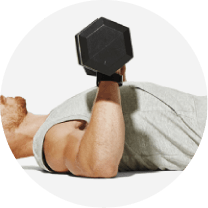28-Days-to-Lean Meal Plan
With the right plan and the right discipline, you can get seriously shredded in just 28 days.
Read article

With the right plan and the right discipline, you can get seriously shredded in just 28 days.
Read article

At age 62, "Big Bill" shares his wisdom to dominate one of the ultimate strength marks.
Read article
Follow these fit women we're crushing on for inspiration, workout ideas, and motivation.
Read article

There are many factors to consider when designing the perfect program—sets and reps, exercise order, and weights are all important. But when’s the last time you paid attention to your rest time? Typically speaking, we don’t give too much thought to the downtime during gym work. Taking a minute or two to recover before knocking out your next set of biceps curls or back squats is standard, and it normally works, so if it’s not broke, don’t fix it, right? Wrong. It’s time to rethink this strategy. Because, by playing with your rest times—specifically, making them shorter—you can improve the results of your training in terms of size, strength, and fat burning without having to alter any other part of your program. It doesn’t get more hassle-free than that.
On the one hand, longer rest periods equal more recovery time for fatigued muscles, which allows you to complete more reps on successive sets. The more reps you can do with a given weight, the stronger you’ll become and the more muscle growth you’ll stimulate. In fact, one study comparing a 2½-minute rest period between sets with a one-minute period reported that novice lifters using the longer rest periods for 10 weeks increased their biceps size by 12%, while the shorter-resting group had only a 5% increase. However, novice lifters’ muscles respond much differently to training than do those of the more experienced, so while this study may hold water for newbies, it’s not as pertinent to seasoned gym rats.

Follow these nutrition rules to maximize your mass-building potential.
Read articleWhen it comes to muscle hypertrophy and strength gains, other factors come into play, such as the biochemical changes in muscle that are triggered by fatigue. Such fatigue can lead to higher growth hormone and insulin-like growth factor-1 (IGF-1) levels, which can encourage better gains in muscle size. One study of trained male lifters in Brazil had one group training for eight weeks using an eight- to 10-rep range with a two-minute rest period between sets. Another group started out using a two-minute rest, then reduced it by 15 seconds each week until they were down to 30 seconds between sets in the eighth week. Researchers found that those dropping their rest times each week increased their arm size by 21% and leg size by 28%, while the group keeping rest constant at two minutes increased by only 14% and 19%, respectively. These results are mainly due to the fact that, as rest periods decrease, chemical stress increases. That chemical stress activates biochemical pathways that signal muscle growth, such as higher IGF-1 production, especially within muscle cells.
The gradual reduction in rest periods also trains the muscles to recover more quickly between sets, which results in greater strength and endurance. This ability to do more work in less time also triggers changes in the muscle that encourage growth. Fat burning is enhanced, too—yet another benefit of shortened rest periods.
These findings are precisely why M&F created the Time Out program below. You’ll start off resting two minutes between sets, and each week you’ll shave off 15 seconds until you’re down to just 30 seconds of rest in Weeks 7 and 8. This will lead to more muscle, more endurance, more strength, and less fat—all while shortening your training time.

To get wicked strong, you need to have a variety of lifts in your repertoire.
Read articleIn addition to changing rest periods, this program delivers variety in every workout. Each exercise performed for a muscle group uses a different rep range; you’ll start with low reps and go up from there, which will bring you better gains in size, strength, and endurance, not to mention enhanced fat loss. Most muscle groups start off with a multi-joint exercise or two, done with heavier weight and low reps (six to eight for the first exercise, eight to 10 for the second) to place more overload on the target muscles before you get too fatigued. Then you’ll switch to single-joint moves, with higher reps using lighter weight (12 to 15 and 15 to 20 reps on the third and fourth exercises, respectively).
The program uses a four-day split in which opposing muscle groups are paired. For example, you’ll train chest and biceps together in Workout 1 and back and triceps in Workout 4. This will ensure that smaller muscle groups don’t get too fatigued early in the workout. On Day 1, because biceps won’t be affected much by your chest workout, they’ll be relatively fresh when you train them; same goes for triceps on Day 4. With longer rest periods, this may not be as much of an issue. But once you get down to 30 to 45 seconds between sets, the intensity of your workouts will be such that you’ll want to give every muscle group ample opportunity to recover and reap the strength, size, and fat-burning benefits of the Time Out program.
| Week | Rest Periods Between Sets |
|---|---|
| 1 | 2:00 |
| 2 | 1:45 |
| 3 | 1:30 |
| 4 | 1:15 |
| 5 | 1:00 |
| 6 | 0:45 |
| 7 | 0:30 |
| 8 | 0:30 |


Tampa Bay Rays S&C Coach Joey Greany shares his plan to help you run like an All-Star.

Get a little bit of fresh air while you're also getting a good sweat going.

The 2023 Men’s Physique champ hits chest day hard.






